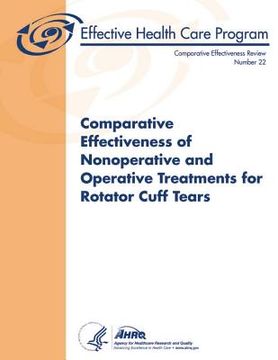Comparative Effectiveness of Nonoperative and Operative Treatments for Rotator Cuff Tears: Comparative Effectiveness Review Number 22
Synopsis "Comparative Effectiveness of Nonoperative and Operative Treatments for Rotator Cuff Tears: Comparative Effectiveness Review Number 22"
The rotator cuff (RC) is comprised of four muscle-tendon units, which stabilize the humeral head within the shoulder joint and aid in powering the movement of the upper extremity.1 RC tears refer to a partial or full discontinuation of one or more of the muscles or tendons and may occur as a result of traumatic injury or degeneration over a period of years. The incidence of RC tears is related to increasing age; 54 percent of patients over the age of 60 years have a partial or complete RC tear compared with only 4 percent of adults under 40 years of age. Although not a life-threatening condition, RC tears may cause significant pain, weakness, and limitation of motion. Both nonoperative and operative treatments are used in an attempt to relieve pain and restore movement and function of the shoulder. The majority of patients first undergo 6 weeks to 3 months of nonoperative treatment, which may consist of any combination of pain management (medications and injections), rest from activity, passive and active exercise, and treatments with heat, cold or ultrasound. Failing nonoperative treatment, the cuff may be surgically repaired using an open, mini-open, or all-arthroscopic approach. A variety of postoperative rehabilitation programs are used to restore range of motion, muscle strength, and function following operative treatment. Earlier operative treatment has been proposed to improve patient outcomes and result in an earlier return to work, and decreased costs; therefore, patients and clinicians face the difficult decision of when to forgo attempts at nonoperative treatment in favor of operative treatment. Moreover, the comparative effectiveness of the various nonoperative and operative treatment options for patients with RC tears remains uncertain. The following key questions (KQ) were investigated for a population of adult patients with partial- and full-thickness RC tears; they include but are not limited to: 1. Does early surgical repair compared to late surgical repair (i.e., nonoperative intervention followed by surgery) lead to improved health-related quality of life, decreased disability, reduced time to return to work/activities, higher rate of cuff integrity, less shoulder pain, and increased range of motion and/or strength? 2. What is the comparative effectiveness of operative approaches (e.g., open surgery, miniopen surgery, and arthroscopy) and postoperative rehabilitation on improved health related quality of life, decreased disability, reduced time to return to work/activities, higher rate of cuff integrity, less shoulder pain, and increased range of motion and/or strength? 3. What is the comparative effectiveness of nonoperative interventions on improved health related quality of life, decreased disability, reduced time to return to work/activities, higher rate of cuff integrity, less shoulder pain, and increased range of motion and/or strength? Nonoperative interventions include, but are not limited to, exercise, manual therapy, cortisone injections, acupuncture, and treatments and modalities typically delivered by physical therapists, osteopaths, and chiropractors. 4. Does operative repair compared with nonoperative treatment lead to improved health related quality of life, decreased disability, reduced time to return to work/activities, higher rate of cuff integrity, less shoulder pain, and increased range of motion and/or strength? 5. What are the associated risks, adverse effects, and potential harms of nonoperative and operative therapies? 6. Which demographic (e.g., age, gender, ethnicity, comorbidities, workers' compensation claims) and clinical (e.g., size/severity of tear, duration of injury, fatty infiltration of muscle) prognostic factors predict better outcomes following nonoperative and operative treatment?

